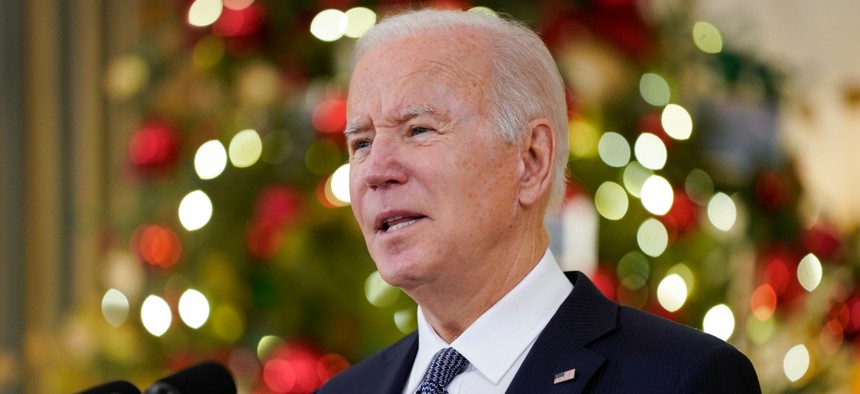
Evan Vucci / AP
Biden Signs Measure to Avoid Shutdown, But Debt Default Threat Still Looms
Congress has 10 weeks to pass full-year funding, but even less time to address the debt limit.
President Biden on Friday signed a 10-week stopgap spending bill, removing the immediate threat of a government shutdown.
Agencies are not out of the woods yet, however, with a new deadline for an entirely separate issue potentially just weeks away. The Treasury Department is set to reach its borrowing limit as soon as Dec. 15, Secretary Janet Yellen recently warned lawmakers. With no clear plan to address the situation, a debt default—and its accompanying catastrophic impact on agencies and the U.S. economy—once again remains on the table.
Congress faced a similar deadline in October, but lawmakers agreed to a $480 billion increase to the debt limit to buy themselves a few months. Republicans have largely insisted that Democrats pass an increase or suspension of the debt ceiling on their own, pushing the Senate majority to use a process known as reconciliation that would only require 51 votes. According to several reports, Senate Majority Leader Chuck Schumer, D-N.Y., and Minority Leader Mitch McConnell, R-Ky., are also discussing the possibility of including a provision to address the debt ceiling in the annual defense authorization bill.
There is no blueprint for how the government would operate if it breaches its debt ceiling, though it is clear agencies would not be able to carry out their normal operations. Because typical spending outpaces the revenue the Treasury Department brings in on a given day, the federal government would only be able to pay 60% of its bills in a given month of a default scenario, according to a Bipartisan Policy Center estimate.
Analysts and Treasury officials have sketched out two possible outcomes during a default: the government would either delay payments until it collected enough revenue to cover them, or prioritize some payments while allowing others to go unpaid. In either scenario, agency payments to beneficiaries, states, grantees, contractors and, potentially, their own employees, could be disrupted. Some federal workers could be furloughed or asked to continue working on the promise of back pay in the future.
The Bipartisan Policy Center closely tracks government spending and its impact on the debt limit, and said the default date could range from Dec. 21 to Jan. 28.
“Those who believe the debt limit can safely be pushed to the back of the December legislative pileup are misinformed,” Shai Akabas, director of economic policy at the center, said on Friday. “Congress would be flirting with financial disaster if it leaves for the holiday recess without addressing the debt limit.”
The center endorsed a new bipartisan bill, The Responsible Budgeting Act, which would automatically suspend the debt ceiling just before a default in conjunction with expedited consideration of debt reduction measures.
Congress will have to address the debt ceiling with several other pressing issues on its docket. In addition to the defense bill, Democrats are looking to push their $1.9 trillion social and climate spending bill over the finish line. And while Biden on Friday signed a continuing resolution to fund agencies through Feb. 18, lawmakers must now negotiate over full-year appropriations.
“Funding the government isn’t a great achievement,” Biden said just before signing the measure. “It’s the bare minimum of what we need to get done.”
Democrats said the stopgap spending bill will keep pressure on Republicans to come to an agreement on full-year fiscal 2022 appropriations because it contains few “anomalies” that lawmakers use in CRs to provide extra funding for pressing issues. The two parties have yet to agree on the top-line spending totals that would make up the defense and non-defense portions of the fiscal 2022 budget, stymying negotiators from finalizing the 12 individual appropriations bills Congress must pass each year.
“I want to urge Congress to use the time this bill provides to work toward a bipartisan agreement on a full-year funding bill that makes the needed investments in our economy and our people, from public health to education to national security,” the president added.







